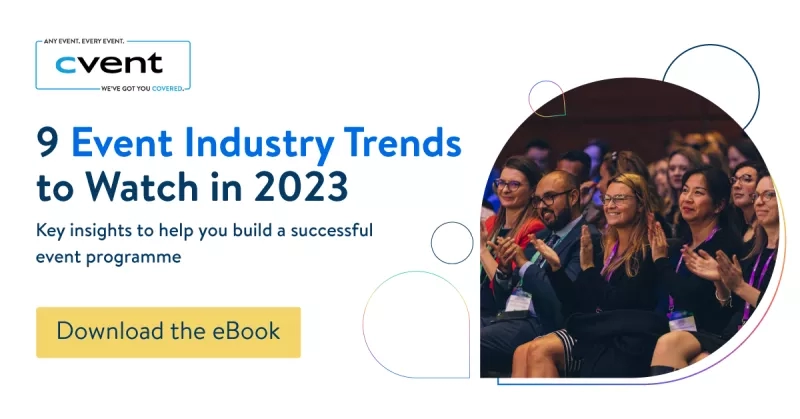The start of 2024 has associations and their members optimistic. The return to in-person events gives a nod to pre-pandemic normalcy. But that optimism is tempered by challenges: hotels are struggling with staffing, service levels at venues have declined, and budgets for travel and events have tightened. Associations themselves are rebuilding their event teams, spending time and resources in the onboarding and training of new employees.
With this landscape in place, 2024 also provides associations with the opportunity to rethink their event programmes. Fluctuations in the job market and increased accessibility of virtual eventshave created new demand for career networking and resources, shining a big opportunity in the market for association membership.
Members and prospects want conveniently accessible content and events and expect associations to deliver on their value propositions. It’s more important than ever for associations to understand what attendees and members want from events. As one of the top sources of non-dues revenue, it is crucial for associations to adapt their events to meet members’ expectations.
As we look ahead to 2024, here are the top five trends to expect in the coming year – and how they will impact your meetings and events.
💡 Looking for a quick breakdown of the top event trends? Check out some of the highlights in our video:
1. Increased digital infrastructure and digitisation
The pivot to virtual events meant significant investments in digital tech. Associations urgently considered and adopted new technology solutions, and both staff and members had to become familiar with the new tools and platforms.
Now that the dust has settled, associations are assessing operational efficiencies, including examining pain points caused by the rapid expansion of their digital infrastructure. This includes ensuring new members’ expectations are being met by their digital experiences. After all, if members aren’t satisfied, engagement will suffer.
Associations must also reexamine their largest value proposition – cultivating a professional community – through a digital lens. While fostering community through in-person experiences is second nature to association planners and marketers, the demand for virtual and hybrid event offerings calls for new strategies that facilitate a digital professional network for members.
This shift has elevated the importance of the Chief Technology Officer, as associations are now held more accountable for their tech stack capabilities and data protection. It also has some interesting implications for association marketers: digitalisation means more data points, which could lead to more actionable insights.
Going forward, in-person events will entail more digital touchpoints, with the help of event tech, which means marketers and planners can capture more valuable insights on attendees’ behavior and interests. This allows planners to create more personalised attendee experiences and offers marketers the chance to create opportunities for always-on, year-round attendee engagement.
Top tip: Make digital elements an integral part of your in-person events to boost and measure attendee engagement before, during, after, and between your events.
2. Events designed with ESG in mind
It’s becoming increasingly important to consider key issues like sustainability and diversity at every stage of event design. These factors demonstrate organisations’ commitment to ESG (Environment, Social, and Governance) policies.
Sustainability
Sustainability is top of mind for many in the events industry. In a Global Business Travel survey, 80% of respondents said their organisation takes sustainability into account when planning meetings and events. Of this group, 76% have implemented a sustainable meeting program strategy.
While sustainability is a clear priority, however, it remains a challenge. The 2022 ICE benchmarking report found that 59% of event planners see sustainability as a challenge for their organisations.
To address this, event organisers will be focusing on measuring and reporting the impact of their sustainability efforts. This means setting measurable goals and tracking their events' carbon footprint, including factors like catering, energy consumption, and distance traveled by attendees.
Diversity, Equity, and Inclusion (DE&I)
DE&I initiatives have become increasingly important in the events industry and will continue to be a priority in 2024. Championing diversity and inclusion will mean a concerted effort to craft events that are more inclusive and accessible to all.
This effort can take many forms and must be considered at every stage of an event. For example, planners can select venues that are 100% accessible or collect relevant attendee information during registration, such as accessibility requirements, to accommodate attendees’ needs.
Prioritising DE&I could also mean selecting speakers with diverse backgrounds, offering virtual opportunities for attendees who cannot attend in person, or making sure you’re using inclusive language throughout all event communications.
3. Intense focus on cost savings, efficiencies, and new revenue models
Rising inflation, combined with high demand and increased event costs, mean organisations will need to increase their event spending this year. A 2022 CWT report estimated the cost-per-attendee for meetings and events to be 25% higher than in 2019 and set to rise another 7% in 2023.
With a potential recession looming, associations are focused heavily on cost savings, proving event ROI, and finding efficiencies across their event and membership programmes.
Adapting the association business model
After a period of such dramatic changes, and with a heightened focus on increasing non-dues revenue and proving ROI, strategic planning has become a top priority, and associations are reexamining their offering models.
Similarly, roles and responsibilities shifted for many association professionals. When events were briefly halted, many associations considered how they could maximise revenue from content and education in a way that hadn’t been done in decades – or ever. Suddenly, Education Managers had to think about revenue generation just as much as industry content.
In a 2021 Membership Marketing Benchmarking Report, 78% of respondents said their associations had developed new products and services, including new content offerings and entirely new membership models. Associations are still experimenting with a la cart pricing and creating membership models that provide flexible and scalable offerings to stay current with member demands and increase member value.
Determining how these new membership models will be monetised, priced, and packaged for the market will continue to be a priority and a challenge for associations. That said, membership growth and retention are unable to provide the revenue stability they once did, and associations must vary their strategies to generate adequate revenue and cut costs.
Cutting costs and boosting revenue at events
Unsurprisingly, events are the number one non-dues revenue generator for associations, even in the face of rising event costs. In addition to the effects of inflation, attendees’ expectations for in-person events have changed, placing a greater important on networking and professional connection rather than content and education. With this shift, the costs of food, beverage, and logistics are also rising.
These increased costs, coupled with the instability of membership revenue, make it more important than ever that associations do what they can to cut costs and maximise event revenue.
A great way to achieve these goals without minimizing the attendee experience? Creative sponsorships. Offering industry partners opportunities to promote their brands in creative new ways can be a fantastic revenue driver.
After several years of experimenting with virtual activations, partners are looking for fun, engaging ways to get their brands and services in front of a targeted pool of prospects. If sponsors and association marketers can get this right, they create a win-win situation.
Top tip: Increase visibility across all your meetings and events to identify opportunities for greater efficiency and cost reduction. Create standardised processes and use technology to help automate manual tasks and bring down your event costs.
4. Using event data for membership retention and growth insights
Thanks to digitisation, event organisers can capture more data insights than ever before. Leveraging the wealth of event data available, associations can gain deeper insights to enhance the attendee experience and increase engagement.
Event data can answer so many questions for event organisers, including:
- Which content resonated most with attendees?
- What would attendees change, and what experiences should be repeated next time?
- Did the event increase membership or boost sponsorship revenue?
Using centralised event data allows event organisers to translate the impact of their events into measurable, reportable outcomes that can be shared with stakeholders and decision-makers. It can also offer insight into how associations can better cater to their membership mix.
After all, to delight attendees and members, you have to know what makes them tick. Associations must be able to analyse and understand their new membership mix to deliver personalised engagement and fulfill their career value propositions.
Unfortunately, many associations struggle to access existing data or do not have a way to consolidate member data spread across multiple platforms. Additionally, finding the right time and talent for actionable analysis can be a challenge.
There’s good news, though! With event tech designed to help associations measure and prove event ROI and create data mapping journeys, you can start collecting and using your data strategically to help you cut costs and increase revenue – without planners and marketers having to become data scientists.
Top tip: To capture the right data, you need the right tools. Ensure you have the right technology in place to see key metrics and inform future event planning.
5. Race for quality space
In-person events are not only back; they’re thriving. But the return to in-person events is happening more rapidly and at a greater volume than anticipated. Consequently, the spike in demand for venues means there is greater competition for event space.
To further complicate the venue sourcing journey, the cost of venues is rising alongside every other cost, and venues are still facing staffing shortages that impact their service offerings and quality of service. In fact, many associations are finding the level of services once provided by their hospitality partners has declined, leaving associations’ own event staff to fill in the gaps.
With all this in mind, it’s imperative to start sourcing venues early in 2024 to get a jump on the competition and take advantage of any deals you can find on quality venues.
Of course, despite the huge revenue brought in by events, there are times when the benefits of in-person events simply can’t outweigh the costs. Associations must carefully evaluate the ROI for each event to determine which format best meets their budgets and their members’ needs.
Considering younger working professionals are typically the population most ripe for joining an association, it’s important to consider their ability to attend in-person events. With limited access to disposable income or employer funds to travel for events, it’s reasonable to assume younger members could more readily afford to attend virtual or hybrid events that incorporate more digital experiences.
Top tip: Take stock of your venue sourcing process and consider making changes to give yourself an advantage in the race for space. By using venue sourcing tools to automate and accelerate the process of finding a suitable venue, you can also find venues that are able to facilitate more digital experiences.
How can associations win in 2024?
Just as the association community remained resilient throughout the pandemic, associations now must resist the urge to become complacent and return to the pre-pandemic status quo with their events. In the current economic conditions, individuals and organisations are looking to subscriptions and services as costs to cut – this includes association memberships. It is critical that association membership be viewed as a “need to have” rather than a “nice to have.”
To keep this momentum, associations must take a thorough look at how their strategies must adapt to new realities. Further, members expect strong value propositions backed by even stronger offerings, trickling down into their events, education, and content. Association leaders must prioritise competing in this space and instruct their teams to mirror events and marketing accordingly.
Despite the numerous challenges facing event organisers, the strong return to in-person events, coupled with increased digitisation, means associations are better equipped to produce events that engage their members and deliver value. Now is the year to solidify a thoughtful event strategy and tactical technology support to have a firm foundation for your association’s success.
To learn more about the key trends shaping the meetings and events industry, download our eBook, 9 Event Trends to Watch Out.








